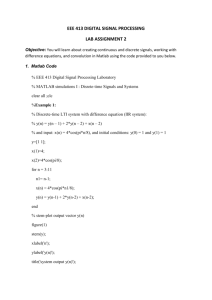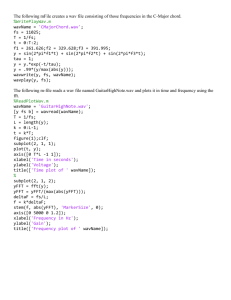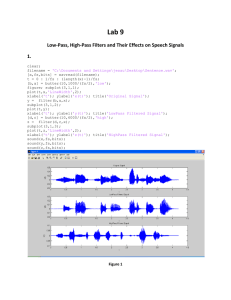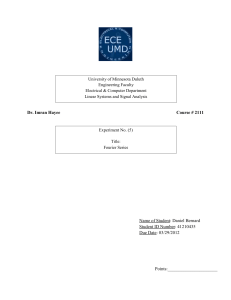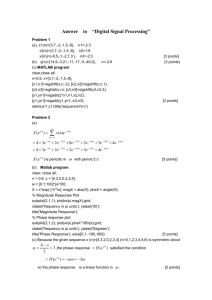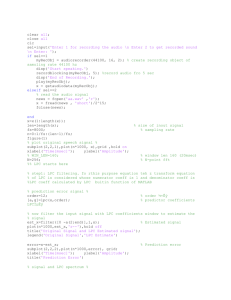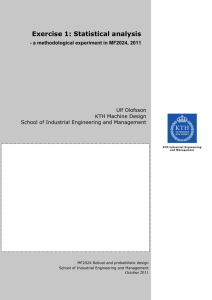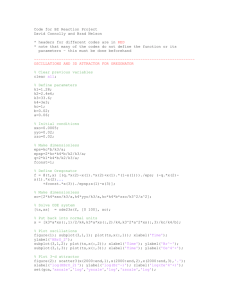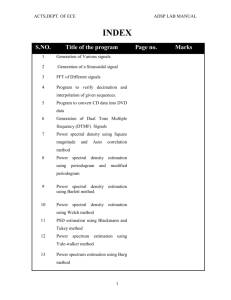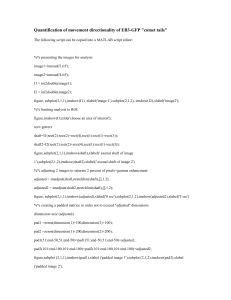File
advertisement
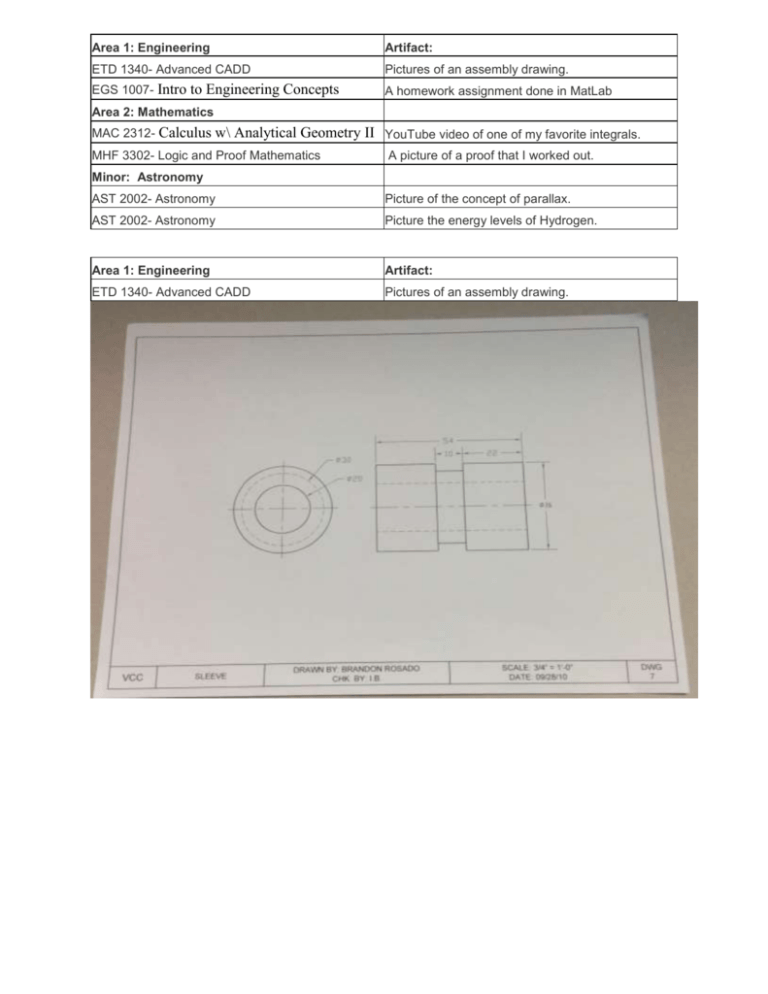
Area 1: Engineering
Artifact:
ETD 1340- Advanced CADD
Pictures of an assembly drawing.
EGS 1007- Intro
A homework assignment done in MatLab
to Engineering Concepts
Area 2: Mathematics
MAC 2312- Calculus
w\ Analytical Geometry II YouTube video of one of my favorite integrals.
MHF 3302- Logic and Proof Mathematics
A picture of a proof that I worked out.
Minor: Astronomy
AST 2002- Astronomy
Picture of the concept of parallax.
AST 2002- Astronomy
Picture the energy levels of Hydrogen.
Area 1: Engineering
Artifact:
ETD 1340- Advanced CADD
Pictures of an assembly drawing.
Area 1: Engineering
Artifact:
EGS 1007- Intro
A homework assignment done in MatLab
to Engineering Concepts
Matlab_Lab3:
1. The distance a projectile travels when fired at an angle is a function of time and can be
divided into horizontal and vertical distances.
H(t) = t Vo cos()
V(t) = t Vo sin() - 1/2 g t2
H(t) and V(t) are the distance traveled in x and y direction. Vo = 100 m/s is the initial velocity, g
= 9.81 m/s2 and t is the time, 0 <t < 20 sec.
Calculate the vertical (V1, V2 and V3) and horizontal (H1, H2, H3) distances traveled for angles
/2, /4 and /6. Graph horizontal distances in x-axis and vertical distances in y-axis for all
three cases. You will have three lines, make one solid, one dashed and one dotted. Add a
legend to identify which line is which.
2. Populations tend to expand as P = Poert , where P is the current population, Po is the original
population, r is the rate, expressed as a fraction, t is the time.
If you originally have 100 rabbits that breed at a rate of 9% per year, find how many rabbits you
will have at the end of each year for 30 years. Create a plot with three subplots. In the first
subplot plot t versus P on a rectangular coordinate system. In the second subplot; plot t versus
P, scaling the x-axis logarithmically. In the third subplot; plot t versus P, scaling both axes
logarithmically. Add title to each graph.
3. The vector G represents the distribution of final scores in a course.
G = [68, 70, 56, 78, 97, 65, 87, 84, 72, 90, 99, 85, 79, 96, 64, 88, 76]
(a) Use Matlab to sort the data and create a bar graph of the sorted scores. Add Title, and axis
labels.
(b) Create a histogram of the scores. Add Title, and axis labels.
4. Create a vector of x values from 0 to 20, with an increment of /100.
y = x sin(x)
and
z = x cos(x)
(a) Create an x-y plot of y.
(b) Create a polar plot of x and y.
>>%Problem #1
>> t = [0:20];
>> V = 100;
>> g = 9.81;
>> H1 = t*V*cos(pi/6);
>> V1 = t*V*sin(pi/6)-(1/2)*g*t.^2;
>> H2 = t*V*cos(pi/4);
>> V2 = t*V*sin(pi/4)-(1/2)*g*t.^2;
>> H3 = t*V*cos(pi/2);
>> V3 = t*V*sin(pi/2)-(1/2)*g*t.^2;
>> plot(H1,V2, H2,V2,':', H3,V3,'--')
>> axis([-100 2000 0 600])
>> legend('H1 V1', 'H2 V2', 'H3 V3')
>> title('Projectile Distance'); xlabel('Horizontal Distance'); ylabel('Vertical Distance')
>> axis([-100 2000 -600 500])
>> % Problem #2
>> p=100;
>> r = .09;
>> t = 1:30;
>> P = p*exp(r*t);
>> subplot(2,2,1), plot(t,P), title('t vs. P'); subplot(2,2,2), semilogx(t,P), title('semilog t vs.
P');subplot(2,2,3), loglog(t,P), title('log t vs. log P');
>>% Problem 3a
>> G = [68 70 56 78 97 65 87 84 72 90 99 85 79 96 64 88 76];
>> bar(sort(G)), title('Final Scores'), xlabel('Students'), ylabel('Scores');
>> % Problem 3b
>> hist(sort(G)), title('Final Scores'), xlabel('Number of Students'), ylabel('Scores');
>> %Problem 4
>> x = 0:pi/100:20*pi;
>> %Problem 4a
>> y = x.*sin(x);
>> z = x.*cos(x);
>> plot(x,y), title('x vs. y'), xlabel('x axis'), ylabel('y axis');
>> % Problem 4b
>> polar(x,y), title('Polar x vs. y'), xlabel('x axis'), ylabel('y axis');
Area 2: Mathematics
MAC 2312- Calculus
w\ Analytical Geometry II YouTube video of one of my favorite integrals.
This is not my own work. The owners YouTube handle is Sy Le .
http://www.youtube.com/watch?v=nf8OUCSAjk8
Area 2: Mathematics
MHF 3302- Logic and Proof Mathematics
A picture of a proof that I worked out.
Minor: Astronomy
AST 2002- Astronomy
Picture of the concept of parallax.
d = 1/p
Minor: Astronomy
AST 2002- Astronomy
Picture the energy levels of Hydrogen.
Area 1: Engineering
Artifact:
Informative video on how to change the oil of my
Learning how to change the oil in my car.
Doing home and improvement around the house.
car.
A photo of my uncle and I putting up drywall.
Area 2: Mathematics
Tutoring someone in mathematics.
Creating a formula that shows how much money I
spend a year on bills.
Written statement from student telling how much
they have accomplished in math.
A photo of the equation that I came up with.
Minor: Astronomy
Me visiting the observatory at UCF.
Photo of me next to a telescope.
Doing an experiment with the phases of the moon.
A photo of me collecting data, and my final results.
My education has come from many places, but I do believe that most of it has been informal. The way I
look at it, if you compare the amount of time we have spent outside of a formal educational setting to
the time inside, you will see that we have been in an informal setting way more often. Not to mention, if
you consider the amount of knowledge you gain from the time you are born to the time we first go to
school, the amount of informal education has a very large lead. We start off as little breathing creatures
that only know how to cry and drink milk. Then after about 3 years, we were already communicating,
processing longer thoughts, and most importantly we learn about imagination. From this point, the
amount of knowledge you gain from formal education never catches up with the amount of informal
education because of this “lead” that informal education has.
Although informal education grossly outweighs formal education, I do think that a formal education is
necessary to help continue you the growth of your informal knowledge. What I mean is that without our
formal education, the amount of informal knowledge that you can grasp will eventually level off. The
reason for this is that the knowledge you gain in a formal setting exponentially increases the level of
your thought process, allowing you to learn more things and link more thoughts together. Both forms of
education are necessary for survival and are dependent upon each other for growth, but in the long run,
the amount informal education will be far greater. Regardless of which has been more pertinent my life,
every second that we are breathing is an opportunity to learn, and I plan to learn until the day that I die.

